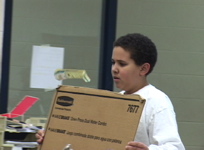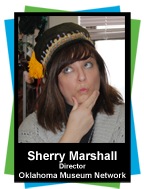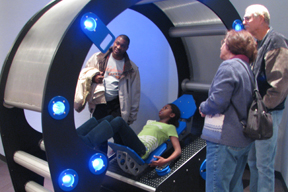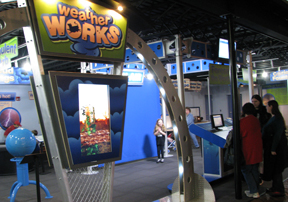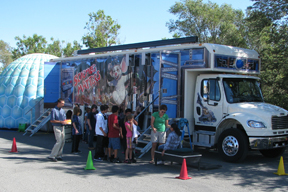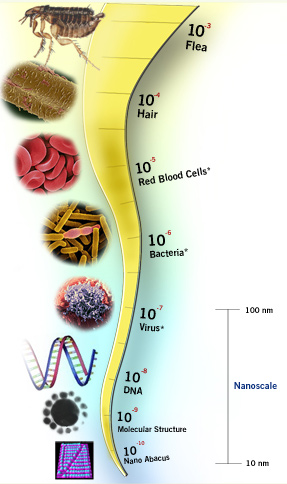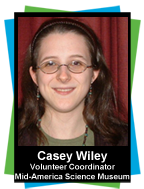
To help celebrate National Engineering Week (Feb 20 – 26), we wanted to share this exhilarating engineering activity you can do at home, (provided by Casey Wiley, volunteer coordinator at Mid-America Science Museum)!
Do you like roller coasters?
I’ll admit that I’m a huge chicken and refuse to ride one, but I do love to watch them fly through the sky! Did you ever wonder how they work?

The cool thing about science is it’s all around us and touches our lives in so many ways. Scientists aren’t just boring people in lab coats trapped in stinky laboratories. Engineers use physics, math and creativity to design our world, even cool stuff like roller coasters!
 Here’s your chance to be an engineer and design your own dream roller coaster! Try to make it fast, fun and exciting, but don’t lose your marbles (I mean, your passengers)!
Here’s your chance to be an engineer and design your own dream roller coaster! Try to make it fast, fun and exciting, but don’t lose your marbles (I mean, your passengers)!

Materials:
- 5-7 six-foot lengths of foam pipe insulation tubing cut in half lengthwise
- Round toothpicks (approx. 20)
- 16mm marbles (5)
- Container to catch the marbles
- Flexible tape measurer
What to Do
- Design and test a preliminary prototype using one marble, a container to catch the marble, one foam piece, one toothpick and a one-foot piece of masking tape
- As you test, try to think about your final design and the amount of materials that will be needed.
- After 5 minutes, take what you learned from the preliminary prototypes and get the rest of the materials you need.
- Construct your roller coaster! Try to answer the following questions as you test and design your ride!

Questions
- Can you make your roller coaster stand alone?
- Was there a stronger design/construction that seemed to work?
- What did you have to change to keep the marble form falling out?
- Is the ride safe?
- Why do roller coasters have corkscrew turns instead of loop-de-loops?
- How far did your marble travel?
- What happened when you changed the loop?
- What other modifications did you do to make your marble travel farther?
What’s happening?
Engineers use their math and science know-how in all areas of an amusement park. They need to understand how to make rides fast and fun, without compromising structural integrity which is needed for ride safety.
Watch this video about building the roller coasters you see at amusement parks!

 February 20 – 26 is National Engineering Week. If you have an engineer (or two) in your life, hug them. They do important work, like designing my spaceship to travel the universe in search of fresh sources of Nostradimum. Without engineers, I would just have to satisfy myself with taking over the world, but now I can dream much bigger — I’m going to take over the universe!!!
February 20 – 26 is National Engineering Week. If you have an engineer (or two) in your life, hug them. They do important work, like designing my spaceship to travel the universe in search of fresh sources of Nostradimum. Without engineers, I would just have to satisfy myself with taking over the world, but now I can dream much bigger — I’m going to take over the universe!!!
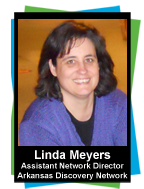 One of the missions of the Arkansas Discovery Network is capacity building at the partner museums, to improve upon what they offer the public. One way we do that is with Educator Workshops. A few weeks ago educators from around the Network got together at the Museum of Discovery to learn how to better present Nanotechnology to their visitors. Educators from each museum shared what has worked and hasn’t worked as far as teaching Nano to the public, and especially children in the younger grades who present a special challenge with this sometimes hard-to-comprehend subject.
One of the missions of the Arkansas Discovery Network is capacity building at the partner museums, to improve upon what they offer the public. One way we do that is with Educator Workshops. A few weeks ago educators from around the Network got together at the Museum of Discovery to learn how to better present Nanotechnology to their visitors. Educators from each museum shared what has worked and hasn’t worked as far as teaching Nano to the public, and especially children in the younger grades who present a special challenge with this sometimes hard-to-comprehend subject.


 Hello and welcome back to our blog! This is Derrick Warren again with another feature from the
Hello and welcome back to our blog! This is Derrick Warren again with another feature from the 


 Hello, citizens, and welcome to the sarcastic portion of the Arkansas Discovery Network’s weekly blog posts. My name is Nichole Ashley, and I am the Museum of Discovery’s Animal Care person.
Hello, citizens, and welcome to the sarcastic portion of the Arkansas Discovery Network’s weekly blog posts. My name is Nichole Ashley, and I am the Museum of Discovery’s Animal Care person.


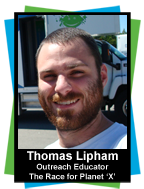 Flight is miraculous, and sending humans in planes or rockets into the sky seems unimaginably dangerous. However through extensive study in physics and aerodynamics, the human race pulled it off over 100 years ago and has even made it safe! Whether it be in a space shuttle, on a unicorn, or the back of a dragon, many young minds fantasize about flight. Therefore I wanted to find an experiment that was simple yet rewarding and fun.
Flight is miraculous, and sending humans in planes or rockets into the sky seems unimaginably dangerous. However through extensive study in physics and aerodynamics, the human race pulled it off over 100 years ago and has even made it safe! Whether it be in a space shuttle, on a unicorn, or the back of a dragon, many young minds fantasize about flight. Therefore I wanted to find an experiment that was simple yet rewarding and fun.